AUCTORES
Globalize your Research
Case Report
*Corresponding Author: Sharayu Dhande, Department of periodontology and Oral Implantology M A Rangoonwala college of dental sciences and research centre, Pune.
Citation: B Jabade, S Dhande, S Sheikh, S Muglikar and S Supnekar. (2022) Localized Ridge Augmentation with Mandibular Block Autograft and Guided Bone Regeneration: A Case Report J, Surgical Case Reports and Images 5(2); DOI: 10.31579/2690-1897/108
Copyright: © 2022, Sharayu Dhande, This is an open access article distributed under the Creative Commons Attribution License, which permits unrestricted use, distribution and reproduction in any medium, provided the original work is properly cited.
Received: 05 April 2022 | Accepted: 14 April 2022 | Published: 27 May 2022
Keywords: chin graft; alveolar ridge augmentation; bone graft; guided bone regeneration; guided tissue regeneration; block grafting; osteo-periosteal flap
Numerous alveolar ridge defects resulted post extraction, long standing periodontal disease often require surgical intervention before prosthetic rehabilitation. On the other hand, alveolar bone defects affect the prognosis of dental implants and as a result, their reconstruction is must. Although a wide variety of options have been invented, autogenous bone is still the gold standard and has been yielding promising results. The authors report a case of localized alveolar ridge augmentation using autogenous chin block graft in conjunction with other bone substitutes for prosthetic rehabilitation of lower anterior region. Initially, the alveolar ridge was knife edge and the bone volume was insufficient for placement of dental implant. The CBCT analysis post 6 months shows significant increase in bone volume that was now suitable for prosthetic rehabilitation of the edentulous space.
for rehabilitation of edentulous sites. Alveolar ridge undergoes marked resorption within first six months after tooth loss. Numerous reasons are associated with alveolar bone loss starting from tooth loss, sinus pneumatization, periodontal disease, facial and dentoalveolar trauma, odontogenic and non-odontogenic cysts and tumours, oral pathologic lesions, and a variety of other systemic conditions [1].
One of the essential requirement for placement of dental implants is presence of adequate alveolar bone for achieving accurate bio-mechanical and functional position and to create natural soft tissue profile with long-lasting implant stability [2]. Thus, reconstruction of lost alveolar bone is of prime concern. Variety of alveolar ridge augmentation procedures have been studied till date viz, autogenous bone grafting, guided bone regeneration, distraction osteogenesis, ridge splitting, onlay bone grafting, maxillary sinus augmentation, etc [3]. These procedures not only help achieve ideal implant positioning but also favor prosthetic rehabilitation. Few of these procedures aid in horizontal ridge augmentation while few aid in vertical ridge augmentation [4,5]. The selection modality depends on variety of factors such as defect morphology, number of walls remaining etc. Owing to their inherent osteo-genetic, osteoconductive and osteo-inductive properties that aid in regeneration of lost bone volume [6]. autogenous (cortical/trabecular) bone grafting remains gold standard till date.
Autogenous bone grafting can be done in the form of block grafts or particulate graft. Block grafts are further classified according to their site of origin as intra-oral and extra-oral. Extra-oral block grafts require need for hospitalization, alteration in ambulation, second surgical site operation under general anesthesia. Indeed, the use of intra-oral block grafts has been considered aggressively owing to its ease of accessibility and less discomfort. Most common intraoral sites used are chin, ramus of mandible, or any edentulous alveolar site. Symphysial region is one of the easiest site for harvesting the graft and also has the advantage of highest amount of cortico-cancellous bone. The mandibular symphysis site should be evaluated for any hard and soft tissue deficiencies, presence of adequate amount of attached gingiva, depth of the vestibule, and endodontic and periodontal assessment of anteriors. Few complications like graft rejection, graft exposure, nerve injury are associated with block grafting and as a result necessary precautions to avoid the same should be well taken care off [7-9].
The concept of guided tissue regeneration was given by Nyman et al that utilizes resorbable and non-resorbable barrier membrane with or without bone grafts. These membranes are most commonly used with bone grafts that further act as a support to the membranes [10].
Due to horizontal and vertical bone deficiency in the present case, a combined horizontal as well as vertical ridge augmentation was a treatment of choice. As a result, autogenous bone grafting with particulate bone grafts was selected as the treatment of choice. This article presents a case report of localized ridge augmentation with mandibular block autograft and guided bone regeneration.
A 45 year old male patient reported to the clinic with the chief complaint of missing tooth in lower front region of jaw. Patient reported no significant contributory medical history.
CBCT was advised to know lost alveolar bone dimensions. Clinical and radiographic examination revealed severe horizontal and vertical alveolar ridge deficiency which indicated severe bone resorption in lower anterior region between 42 and 31 (Figure No 1). Bone height was 19.1mm and 2.5mm in width respectively which was insufficient for prosthetic rehabilitation of that region. As a result, an intra-oral block graft combined with other bone substitutes was considered as treatment of choice since vertical as well as horizontal ridge augmentation was required. The treatment plan was explained and discussed with the patient and accordingly treatment was initiated. Routine haematological investigations were performed and a written informed consent was obtained from the patient.
The surgical phase was initiated with extraoral scrubbing with 5
Pre-operative CBCT examination revealed bone height of 19.1mm and width of 2.5mm respectively (Figure No 9); while the CBCT examination at the end of 6 months showed a bone gain of 21.4mm in height and 4.0mm in width in horizontal and vertical ridge (Figure No 10). As a result, the total gain in bone height was 2.3mm and bone width was 1.5mm.
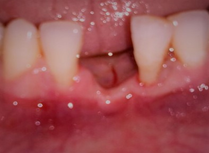
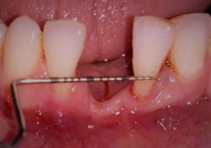


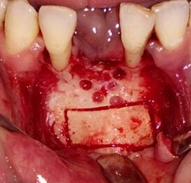

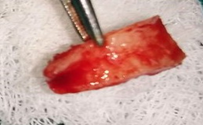

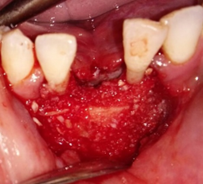
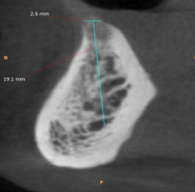

The prognosis of dental implant does not merely depend upon osseointegration but also on establishment of an ideal base for implant supported prosthetic reconstruction. The available literature evidence supports placement of implant in alveolar ridge width of atleast 5 mm and a bone height of 8-10mm for favourable outcomes. Any alterations in the ridge dimensions and available bone predispose the placement in anatomically compromised conditions further increasing the chances of implant failure. As a result, a variety of techniques have been employed till date for horizontal ridge augmentation including the use of numerous bone grafts, guided bone regeneration with resorbable and non-resorbable membranes and also with titanium mesh, ridge splitting, alveolar distraction osteogenesis and use of block grafts [11].
Although, a variety of bone grafting and bone substitute materials have been available now, intra-membranous autogenous bone grafting remains gold standard till date due to its inherent osteogenic, osteoconductive and osteo-inductive properties [12].
In the present case report, the reason behind selection of chin as the bone harvesting site was mainly because of ease of access to chin and was closer to recipient site making second surgical site avoidable, along with that sufficient amount of cortico-cancellous nature of the symphysial bone help in enhancing revascularising property of the cancellous bone and mechanical support with rigidity of the cortical bone
Giesenhagen in 2006 was the first to report bone-ring technique and he stated this technique could help provide 3-dimensional augmentation followed by immediate implant placement in a single surgical visit [13]. Pommer et al 2008 reported a new set of guidelines for harvesting block graft, in 56% of patients donor site can be used for harvesting graft of about 10mm, whereas a 8mm of graft could be easily harvested from this region in about 74%, inadvertently a large number of patients about 90% of them could provide only 6mm of graft. The remaining of 10% population is considered not so suitable for harvesting chin graft [14]. Bansal et al 2014 carried out prosthetic rehabilitation of missing anterior periodontally compromised tooth treated with natural tooth pontic preceded by horizontal bone augmentation using autogenous chin block graft yielded excellent results [15]. In parallel, Desai et al 2015 used autogenous chin block graft at periodontally compromised extraction site is a promising option [16].
In our present case we procured chin graft through piezosurgery owing to its high precision and operating sensitivity and ease to differentiate between cortical and cancellous bone while procuring block.
As space maintainance is one of the main criteria for GBR, in the present case DFDBA (60%) infused with Perioglas (40%) to fill the inter-block space was preferred with resorbable collagen membrane cologide to reduce bone resorption. Comparably, in our case too we used bio-resorbable collagen membrane Cologide. The primary reason behind using resorbable membrane was to refrain complexity of soft tissue dehiscence with mesh. In a study conducted by Maiorana et al 2005, showed use of bovine bone particles (Bio-Oss) with block grafts, help lessen the degree of bone resorption almost up to 9.3% in the test group while 18.3% in the control group.17 In contrast, Khoshhal S 2016 carried out a case of mandibular ridge augmentation using chin graft procured using trephine drills. FDBA 70% infused with DFDBA 30% was used with chin graft [18]. Similarly, in the present case, initially the alveolar ridge was knife edge in nature, 6 months post autologous bone block augmentation, CBCT showed marked increase in ridge width, sufficient enough for placement of a dental implant.
Deepa D 2017 managed a case of localized maxillary posterior alveolar ridge defect by horizontal ridge augmentation with guided bone regeneration using autogenous particulate chin graft followed by placement of hydroxyapatite bio-resorbable membrane Sybograf-GBR [19]. The 6 months post-operative clinical and radiographic examination revealed a significant increase in height and width of the alveolar ridge defect. Thus, the authors concluded that combined treatment approach using autogenous chin graft and GBR membrane is a better option for the treatment of localized posterior alveolar ridge defects which was supporting our treatment plan.
A systematic review and meta-analysis carried out by Gorgis et al 2021 on augmentation of lateral alveolar ridge with an autogenous bone block graft alone with or without barrier membrane coverage also provided predictable results [20]. Likewise in present case, autogenous bone block with resorbable membrane also yielded predictable results.
The set of complications known to be associated with harvesting of the chin graft are viz., pain and discomfort, infection at the donor as well as surgical site, temporary paresthesia, bruising of chin, ptosis of chin, incision line opening, neurosensory deficit of lower lip, dentinal hypersensitivity with lower anterior teeth, post-operative change in the soft tissue contour of chin, decrease in height of lower lip, graft dehiscence. Fortunately, none of the complications were reported by the patient in the present case. Interestingly, the combination of chin graft with particulate bone grafts covered by a collagen membrane has yielded gain in bone dimensions in the present case and as a result [21-23].
Ridge augmentation is undoubtedly a challenging procedure but the use of autogenous chin graft proves to provide predictable results. Furthermore, prognosis of dental implants has been shown to improve in augmented sites. As a result, authors advocate use of symphysial bone graft supplemented with particulate bone graft. Nevertheless, long term follow up will help provide predictable results of autogenous bone grafting with chin graft in case of severely resorbed ridges and thus aid in rehabilitation of partially edentulous ridges.
Clearly Auctoresonline and particularly Psychology and Mental Health Care Journal is dedicated to improving health care services for individuals and populations. The editorial boards' ability to efficiently recognize and share the global importance of health literacy with a variety of stakeholders. Auctoresonline publishing platform can be used to facilitate of optimal client-based services and should be added to health care professionals' repertoire of evidence-based health care resources.

Journal of Clinical Cardiology and Cardiovascular Intervention The submission and review process was adequate. However I think that the publication total value should have been enlightened in early fases. Thank you for all.

Journal of Women Health Care and Issues By the present mail, I want to say thank to you and tour colleagues for facilitating my published article. Specially thank you for the peer review process, support from the editorial office. I appreciate positively the quality of your journal.
Journal of Clinical Research and Reports I would be very delighted to submit my testimonial regarding the reviewer board and the editorial office. The reviewer board were accurate and helpful regarding any modifications for my manuscript. And the editorial office were very helpful and supportive in contacting and monitoring with any update and offering help. It was my pleasure to contribute with your promising Journal and I am looking forward for more collaboration.

We would like to thank the Journal of Thoracic Disease and Cardiothoracic Surgery because of the services they provided us for our articles. The peer-review process was done in a very excellent time manner, and the opinions of the reviewers helped us to improve our manuscript further. The editorial office had an outstanding correspondence with us and guided us in many ways. During a hard time of the pandemic that is affecting every one of us tremendously, the editorial office helped us make everything easier for publishing scientific work. Hope for a more scientific relationship with your Journal.

The peer-review process which consisted high quality queries on the paper. I did answer six reviewers’ questions and comments before the paper was accepted. The support from the editorial office is excellent.

Journal of Neuroscience and Neurological Surgery. I had the experience of publishing a research article recently. The whole process was simple from submission to publication. The reviewers made specific and valuable recommendations and corrections that improved the quality of my publication. I strongly recommend this Journal.

Dr. Katarzyna Byczkowska My testimonial covering: "The peer review process is quick and effective. The support from the editorial office is very professional and friendly. Quality of the Clinical Cardiology and Cardiovascular Interventions is scientific and publishes ground-breaking research on cardiology that is useful for other professionals in the field.

Thank you most sincerely, with regard to the support you have given in relation to the reviewing process and the processing of my article entitled "Large Cell Neuroendocrine Carcinoma of The Prostate Gland: A Review and Update" for publication in your esteemed Journal, Journal of Cancer Research and Cellular Therapeutics". The editorial team has been very supportive.

Testimony of Journal of Clinical Otorhinolaryngology: work with your Reviews has been a educational and constructive experience. The editorial office were very helpful and supportive. It was a pleasure to contribute to your Journal.

Dr. Bernard Terkimbi Utoo, I am happy to publish my scientific work in Journal of Women Health Care and Issues (JWHCI). The manuscript submission was seamless and peer review process was top notch. I was amazed that 4 reviewers worked on the manuscript which made it a highly technical, standard and excellent quality paper. I appreciate the format and consideration for the APC as well as the speed of publication. It is my pleasure to continue with this scientific relationship with the esteem JWHCI.

This is an acknowledgment for peer reviewers, editorial board of Journal of Clinical Research and Reports. They show a lot of consideration for us as publishers for our research article “Evaluation of the different factors associated with side effects of COVID-19 vaccination on medical students, Mutah university, Al-Karak, Jordan”, in a very professional and easy way. This journal is one of outstanding medical journal.
Dear Hao Jiang, to Journal of Nutrition and Food Processing We greatly appreciate the efficient, professional and rapid processing of our paper by your team. If there is anything else we should do, please do not hesitate to let us know. On behalf of my co-authors, we would like to express our great appreciation to editor and reviewers.

As an author who has recently published in the journal "Brain and Neurological Disorders". I am delighted to provide a testimonial on the peer review process, editorial office support, and the overall quality of the journal. The peer review process at Brain and Neurological Disorders is rigorous and meticulous, ensuring that only high-quality, evidence-based research is published. The reviewers are experts in their fields, and their comments and suggestions were constructive and helped improve the quality of my manuscript. The review process was timely and efficient, with clear communication from the editorial office at each stage. The support from the editorial office was exceptional throughout the entire process. The editorial staff was responsive, professional, and always willing to help. They provided valuable guidance on formatting, structure, and ethical considerations, making the submission process seamless. Moreover, they kept me informed about the status of my manuscript and provided timely updates, which made the process less stressful. The journal Brain and Neurological Disorders is of the highest quality, with a strong focus on publishing cutting-edge research in the field of neurology. The articles published in this journal are well-researched, rigorously peer-reviewed, and written by experts in the field. The journal maintains high standards, ensuring that readers are provided with the most up-to-date and reliable information on brain and neurological disorders. In conclusion, I had a wonderful experience publishing in Brain and Neurological Disorders. The peer review process was thorough, the editorial office provided exceptional support, and the journal's quality is second to none. I would highly recommend this journal to any researcher working in the field of neurology and brain disorders.

Dear Agrippa Hilda, Journal of Neuroscience and Neurological Surgery, Editorial Coordinator, I trust this message finds you well. I want to extend my appreciation for considering my article for publication in your esteemed journal. I am pleased to provide a testimonial regarding the peer review process and the support received from your editorial office. The peer review process for my paper was carried out in a highly professional and thorough manner. The feedback and comments provided by the authors were constructive and very useful in improving the quality of the manuscript. This rigorous assessment process undoubtedly contributes to the high standards maintained by your journal.

International Journal of Clinical Case Reports and Reviews. I strongly recommend to consider submitting your work to this high-quality journal. The support and availability of the Editorial staff is outstanding and the review process was both efficient and rigorous.

Thank you very much for publishing my Research Article titled “Comparing Treatment Outcome Of Allergic Rhinitis Patients After Using Fluticasone Nasal Spray And Nasal Douching" in the Journal of Clinical Otorhinolaryngology. As Medical Professionals we are immensely benefited from study of various informative Articles and Papers published in this high quality Journal. I look forward to enriching my knowledge by regular study of the Journal and contribute my future work in the field of ENT through the Journal for use by the medical fraternity. The support from the Editorial office was excellent and very prompt. I also welcome the comments received from the readers of my Research Article.

Dear Erica Kelsey, Editorial Coordinator of Cancer Research and Cellular Therapeutics Our team is very satisfied with the processing of our paper by your journal. That was fast, efficient, rigorous, but without unnecessary complications. We appreciated the very short time between the submission of the paper and its publication on line on your site.

I am very glad to say that the peer review process is very successful and fast and support from the Editorial Office. Therefore, I would like to continue our scientific relationship for a long time. And I especially thank you for your kindly attention towards my article. Have a good day!

"We recently published an article entitled “Influence of beta-Cyclodextrins upon the Degradation of Carbofuran Derivatives under Alkaline Conditions" in the Journal of “Pesticides and Biofertilizers” to show that the cyclodextrins protect the carbamates increasing their half-life time in the presence of basic conditions This will be very helpful to understand carbofuran behaviour in the analytical, agro-environmental and food areas. We greatly appreciated the interaction with the editor and the editorial team; we were particularly well accompanied during the course of the revision process, since all various steps towards publication were short and without delay".

I would like to express my gratitude towards you process of article review and submission. I found this to be very fair and expedient. Your follow up has been excellent. I have many publications in national and international journal and your process has been one of the best so far. Keep up the great work.

We are grateful for this opportunity to provide a glowing recommendation to the Journal of Psychiatry and Psychotherapy. We found that the editorial team were very supportive, helpful, kept us abreast of timelines and over all very professional in nature. The peer review process was rigorous, efficient and constructive that really enhanced our article submission. The experience with this journal remains one of our best ever and we look forward to providing future submissions in the near future.

I am very pleased to serve as EBM of the journal, I hope many years of my experience in stem cells can help the journal from one way or another. As we know, stem cells hold great potential for regenerative medicine, which are mostly used to promote the repair response of diseased, dysfunctional or injured tissue using stem cells or their derivatives. I think Stem Cell Research and Therapeutics International is a great platform to publish and share the understanding towards the biology and translational or clinical application of stem cells.

I would like to give my testimony in the support I have got by the peer review process and to support the editorial office where they were of asset to support young author like me to be encouraged to publish their work in your respected journal and globalize and share knowledge across the globe. I really give my great gratitude to your journal and the peer review including the editorial office.

I am delighted to publish our manuscript entitled "A Perspective on Cocaine Induced Stroke - Its Mechanisms and Management" in the Journal of Neuroscience and Neurological Surgery. The peer review process, support from the editorial office, and quality of the journal are excellent. The manuscripts published are of high quality and of excellent scientific value. I recommend this journal very much to colleagues.

Dr.Tania Muñoz, My experience as researcher and author of a review article in The Journal Clinical Cardiology and Interventions has been very enriching and stimulating. The editorial team is excellent, performs its work with absolute responsibility and delivery. They are proactive, dynamic and receptive to all proposals. Supporting at all times the vast universe of authors who choose them as an option for publication. The team of review specialists, members of the editorial board, are brilliant professionals, with remarkable performance in medical research and scientific methodology. Together they form a frontline team that consolidates the JCCI as a magnificent option for the publication and review of high-level medical articles and broad collective interest. I am honored to be able to share my review article and open to receive all your comments.

“The peer review process of JPMHC is quick and effective. Authors are benefited by good and professional reviewers with huge experience in the field of psychology and mental health. The support from the editorial office is very professional. People to contact to are friendly and happy to help and assist any query authors might have. Quality of the Journal is scientific and publishes ground-breaking research on mental health that is useful for other professionals in the field”.

Dear editorial department: On behalf of our team, I hereby certify the reliability and superiority of the International Journal of Clinical Case Reports and Reviews in the peer review process, editorial support, and journal quality. Firstly, the peer review process of the International Journal of Clinical Case Reports and Reviews is rigorous, fair, transparent, fast, and of high quality. The editorial department invites experts from relevant fields as anonymous reviewers to review all submitted manuscripts. These experts have rich academic backgrounds and experience, and can accurately evaluate the academic quality, originality, and suitability of manuscripts. The editorial department is committed to ensuring the rigor of the peer review process, while also making every effort to ensure a fast review cycle to meet the needs of authors and the academic community. Secondly, the editorial team of the International Journal of Clinical Case Reports and Reviews is composed of a group of senior scholars and professionals with rich experience and professional knowledge in related fields. The editorial department is committed to assisting authors in improving their manuscripts, ensuring their academic accuracy, clarity, and completeness. Editors actively collaborate with authors, providing useful suggestions and feedback to promote the improvement and development of the manuscript. We believe that the support of the editorial department is one of the key factors in ensuring the quality of the journal. Finally, the International Journal of Clinical Case Reports and Reviews is renowned for its high- quality articles and strict academic standards. The editorial department is committed to publishing innovative and academically valuable research results to promote the development and progress of related fields. The International Journal of Clinical Case Reports and Reviews is reasonably priced and ensures excellent service and quality ratio, allowing authors to obtain high-level academic publishing opportunities in an affordable manner. I hereby solemnly declare that the International Journal of Clinical Case Reports and Reviews has a high level of credibility and superiority in terms of peer review process, editorial support, reasonable fees, and journal quality. Sincerely, Rui Tao.

Clinical Cardiology and Cardiovascular Interventions I testity the covering of the peer review process, support from the editorial office, and quality of the journal.

Clinical Cardiology and Cardiovascular Interventions, we deeply appreciate the interest shown in our work and its publication. It has been a true pleasure to collaborate with you. The peer review process, as well as the support provided by the editorial office, have been exceptional, and the quality of the journal is very high, which was a determining factor in our decision to publish with you.
The peer reviewers process is quick and effective, the supports from editorial office is excellent, the quality of journal is high. I would like to collabroate with Internatioanl journal of Clinical Case Reports and Reviews journal clinically in the future time.

Clinical Cardiology and Cardiovascular Interventions, I would like to express my sincerest gratitude for the trust placed in our team for the publication in your journal. It has been a true pleasure to collaborate with you on this project. I am pleased to inform you that both the peer review process and the attention from the editorial coordination have been excellent. Your team has worked with dedication and professionalism to ensure that your publication meets the highest standards of quality. We are confident that this collaboration will result in mutual success, and we are eager to see the fruits of this shared effort.

Dear Dr. Jessica Magne, Editorial Coordinator 0f Clinical Cardiology and Cardiovascular Interventions, I hope this message finds you well. I want to express my utmost gratitude for your excellent work and for the dedication and speed in the publication process of my article titled "Navigating Innovation: Qualitative Insights on Using Technology for Health Education in Acute Coronary Syndrome Patients." I am very satisfied with the peer review process, the support from the editorial office, and the quality of the journal. I hope we can maintain our scientific relationship in the long term.
Dear Monica Gissare, - Editorial Coordinator of Nutrition and Food Processing. ¨My testimony with you is truly professional, with a positive response regarding the follow-up of the article and its review, you took into account my qualities and the importance of the topic¨.

Dear Dr. Jessica Magne, Editorial Coordinator 0f Clinical Cardiology and Cardiovascular Interventions, The review process for the article “The Handling of Anti-aggregants and Anticoagulants in the Oncologic Heart Patient Submitted to Surgery” was extremely rigorous and detailed. From the initial submission to the final acceptance, the editorial team at the “Journal of Clinical Cardiology and Cardiovascular Interventions” demonstrated a high level of professionalism and dedication. The reviewers provided constructive and detailed feedback, which was essential for improving the quality of our work. Communication was always clear and efficient, ensuring that all our questions were promptly addressed. The quality of the “Journal of Clinical Cardiology and Cardiovascular Interventions” is undeniable. It is a peer-reviewed, open-access publication dedicated exclusively to disseminating high-quality research in the field of clinical cardiology and cardiovascular interventions. The journal's impact factor is currently under evaluation, and it is indexed in reputable databases, which further reinforces its credibility and relevance in the scientific field. I highly recommend this journal to researchers looking for a reputable platform to publish their studies.

Dear Editorial Coordinator of the Journal of Nutrition and Food Processing! "I would like to thank the Journal of Nutrition and Food Processing for including and publishing my article. The peer review process was very quick, movement and precise. The Editorial Board has done an extremely conscientious job with much help, valuable comments and advices. I find the journal very valuable from a professional point of view, thank you very much for allowing me to be part of it and I would like to participate in the future!”

Dealing with The Journal of Neurology and Neurological Surgery was very smooth and comprehensive. The office staff took time to address my needs and the response from editors and the office was prompt and fair. I certainly hope to publish with this journal again.Their professionalism is apparent and more than satisfactory. Susan Weiner

My Testimonial Covering as fellowing: Lin-Show Chin. The peer reviewers process is quick and effective, the supports from editorial office is excellent, the quality of journal is high. I would like to collabroate with Internatioanl journal of Clinical Case Reports and Reviews.

My experience publishing in Psychology and Mental Health Care was exceptional. The peer review process was rigorous and constructive, with reviewers providing valuable insights that helped enhance the quality of our work. The editorial team was highly supportive and responsive, making the submission process smooth and efficient. The journal's commitment to high standards and academic rigor makes it a respected platform for quality research. I am grateful for the opportunity to publish in such a reputable journal.
My experience publishing in International Journal of Clinical Case Reports and Reviews was exceptional. I Come forth to Provide a Testimonial Covering the Peer Review Process and the editorial office for the Professional and Impartial Evaluation of the Manuscript.

I would like to offer my testimony in the support. I have received through the peer review process and support the editorial office where they are to support young authors like me, encourage them to publish their work in your esteemed journals, and globalize and share knowledge globally. I really appreciate your journal, peer review, and editorial office.
Dear Agrippa Hilda- Editorial Coordinator of Journal of Neuroscience and Neurological Surgery, "The peer review process was very quick and of high quality, which can also be seen in the articles in the journal. The collaboration with the editorial office was very good."

We found the peer review process quick and positive in its input. The support from the editorial officer has been very agile, always with the intention of improving the article and taking into account our subsequent corrections.
